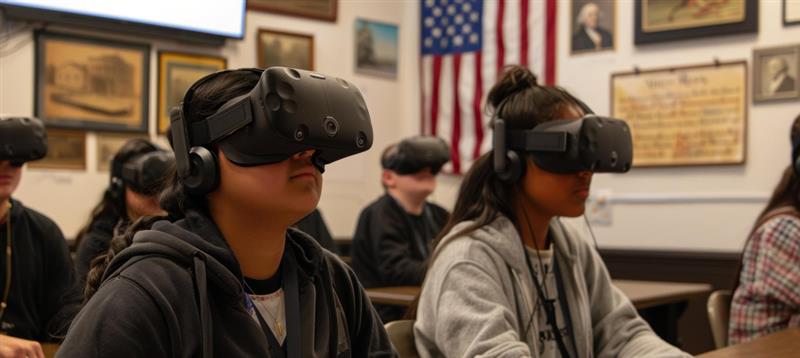Goal-setting is an important skill that every student can benefit from, regardless of their age or academic level.
Research indicates that goal setting positively impacts students of all ages and grades. For instance, a study involving elementary students with low math skills found that setting short-term goals improved their academic performance, as well as their intrinsic motivation and self-confidence.
Goal-setting strategies are essential tools for students, helping them navigate their academic journeys and personal growth. By setting clear, achievable goals, students can enhance their performance and develop essential skills for future success.
This blog explores the importance of goal-setting strategies and offers practical ways to implement goals effectively in everyday life.
What is goal setting for students?
Goal setting for students involves establishing specific, measurable objectives that guide their academic and personal development. It helps students focus their efforts, stay motivated, and track their progress, ultimately leading to improved performance and a sense of achievement.
But what is the power of goal-setting and how can students implement goal-setting strategies? Let’s explore.
Why is Goal-setting Important for Students?
Goal-setting is important for students as it provides focus and direction, boosts motivation, and enhances time management skills. Additionally, it fosters self-discipline and accountability, contributing to overall personal growth and development.
1. Focus and Direction
Setting goals provides students with a clear focus. When students outline their objectives, they have a target to aim for. This clarity can reduce feelings of overwhelm and indecision, making it easier to prioritize tasks and manage time effectively.
2. Enhanced Motivation
Goals can serve as a source of motivation. When students set and achieve small, manageable goals, they feel a sense of accomplishment. This positive reinforcement encourages them to aim for larger goals and keep them motivated.
3. Time Management Skills
Goal-setting helps students to improve their time management skills. By breaking larger goals into smaller, actionable steps, they learn to organize their tasks effectively. This helps them to balance academics with extracurricular activities and personal interests.
4. Self-Discipline and Accountability
Establishing goals requires self-discipline. When students commit to their objectives, they learn the importance of sticking to their plans. This sense of accountability not only benefits their academic life but also prepares them for the responsibilities of adulthood.
5. Personal Growth
Setting goals encourages self-reflection. Students must assess their strengths and weaknesses to create effective goals, which fosters a deeper understanding of themselves. This self-awareness is crucial for personal development and helps them make informed decisions about their future.
How to Implement Goal-Setting with Students?
To implement goal-setting with students, use the SMART goals framework to create specific, measurable, achievable, relevant, and time-bound objectives. Encourage students to write their goals down, break them into manageable steps, and track their progress regularly. Students require a supportive environment where they can seek guidance and encouragement from teachers and mentors.

Following are some strategies for goal-setting:
1. SMART Goals Framework
One effective way to set goals is through the SMART criteria—Specific, Measurable, Achievable, Relevant, and Time-bound. This framework ensures that goals are clear and attainable, making it easier for students to track their progress.
- Specific: Define the goal clearly. Instead of saying “I want to improve my grades,” specify “I want to raise my math grade from a C to a B.”
- Measurable: Establish criteria for measuring progress. For instance, “I will complete five math practice tests.”
- Achievable: Ensure the goal is realistic. Consider current commitments and skills to set a feasible objective.
- Relevant: Align the goal with broader life or academic aspirations, making it meaningful.
- Time-bound: Set a deadline to create urgency. For example, “I will achieve my target by the end of the semester.”
2. Write It Down
Documenting goals can significantly enhance commitment. Students should write down their goals in a visible place, such as a planner or a whiteboard. This visual reminder helps keep their objectives top of mind and serves as a motivational tool.
3. Break It Down
Encourage students to break larger goals into smaller, manageable steps. For example, if a student’s goal is to write a research paper, they can divide it into tasks like selecting a topic, conducting research, and drafting sections. This simplifies the goal-setting process and makes it more achievable.

4. Regular Tracking
A routine review is crucial to track the progress. Students should regularly assess their goals, celebrate small achievements, and adjust plans when needed.
Thanks to technology, students can now use various free goal-tracking applications like Coach.me, ClickUp, Toodledo, Todoist, etc. These goal-setting apps help students track the progress and also allow them to set reminders and review weekly reports.
5. Seek Support
Encourage students to seek guidance from teachers, mentors, or peers. Sharing goals with others creates a support system that can provide encouragement and accountability, making the journey toward achieving goals more enjoyable and effective.
Conclusion
Goal-setting is not just a useful academic tool; it’s a vital life skill that fosters personal growth, enhances motivation, and teaches valuable lessons in time management and discipline.
By implementing effective techniques, such as setting SMART goals and fostering a supportive environment, educators can help students develop essential skills that will serve them well beyond the classroom.









